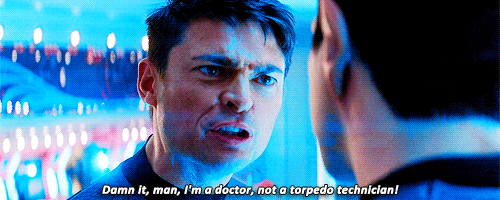The Universal Translator
I watch way more sci-fi than is probably healthy. When we hear “universal translator” I picture Captain Kirk and Jean-Luc Picard beaming down to a new planet and immediately being able to talk to the inhabitants in their own language, no Duolingo or Rosetta stone needed. But when they return to their ships the engineers still need to explain complicated topics with metaphors and long winded pseudoscience technobabble. Bones (Dammit Jim, I’m a doctor) McCoy, has stated this gap in understanding so much it has become a meme.
Some of the early experiments with generative AI chatbots are promising to go farther than the universal translator in Star Trek. I was listening to a podcast featuring Sal Kahn of Kahn Academy on a wild trip to Kansas. Kahn Academy has been offering easy to understand lessons in math, science, economics, and more to everyone interested for 15 years. Sal Kahn believes education should be accessible and most important, understandable.
So when generative AI started wowing people with its ability to instantly generate essays Kahn and his team didn't see the death of education, he saw the chance to reinvent it. As he outlines in his ted talk from May of this year, the Kahn Academy started to experiment with a chatbot that could meet students where they were the same way a good teachers assistant would do. Just like Hip-Hop breathed new life into the story of Alexander Hamilton, we’re beginning to scratch the surface of how education can translate timeless classics into our current experience.
Shared Language
We mistake sharing a common language with speaking the same language. Working deep in complex topics might require us to take shortcuts when talking to our peers. This manifests as industry jargon or acronyms which can be every bit as complex as a foreign language. At best, this allows us to quickly communicate with people who are trained in the same fields. At worst, it creates barriers for new people entering a field.
Rather than push back on the increasing complexity that forms in an isolated group we build translation mechanisms through training, documentation or new job roles. This can allow a specialized group (maybe engineers or scientists) to spend more time creating more and more complex ways to speak to themselves. An alternative is to couple the specialized group to their stakeholders and not let the shared language stray too far apart. This creates some overhead but pays dividends in the long run.
This can be easier than it looks, and language can be brought back together with some shared activities. Here are a few that have worked for me in the past:
Allow engineers to present to executives, give feedback on those presentations. We actually did this for an entire summer internship at IBM and I still think deeply about my target audience going into every presentation.
Have them sit in on customer calls and hear from the personas they are building for and see how the product is being sold or supported.
Create communication channels for people interacting with users to openly discuss development choices.
Send the team to a recruiting fair, nothing helps develop a simplified pitch than 50+ students asking “Why?”
Each of these activities is built around a feedback loop for the team to push back against the creation of jargon and insider terms. By providing immediate feedback they are forced to actively consider how to distill what they are trying to communicate.
The risk and the reward
There is an inherent difficulty with AI chatbots automating these communication paths. It might become even easier for specialized fields to develop whole new jargon. If everything can instantly be translated, why do we need to work at being understood? This could lead to even more entrenched language because nothing is pushing back.
Alternatively, we have the opportunity to break down the barriers that have formed in specialized fields. This can bring newcomers with fresh perspectives into hard to access professions and could revolutionize how we approach education. Already we’ve seen messaging services break down language barriers allowing us to communicate directly with our colleagues in different countries in our own words.
We can use this new technology as a crutch or as a tool. Deployed correctly we can unlock an enormous amount of human potential by opening the doors to inaccessible fields. If we use it to cover up our existing poor communication pathways, it will very easily make those pathways worse. As we deploy these new magical universal translators we should be asking ourselves, “Are the tools we are building enabling deeper human connection by making complex topics more accessible?”


